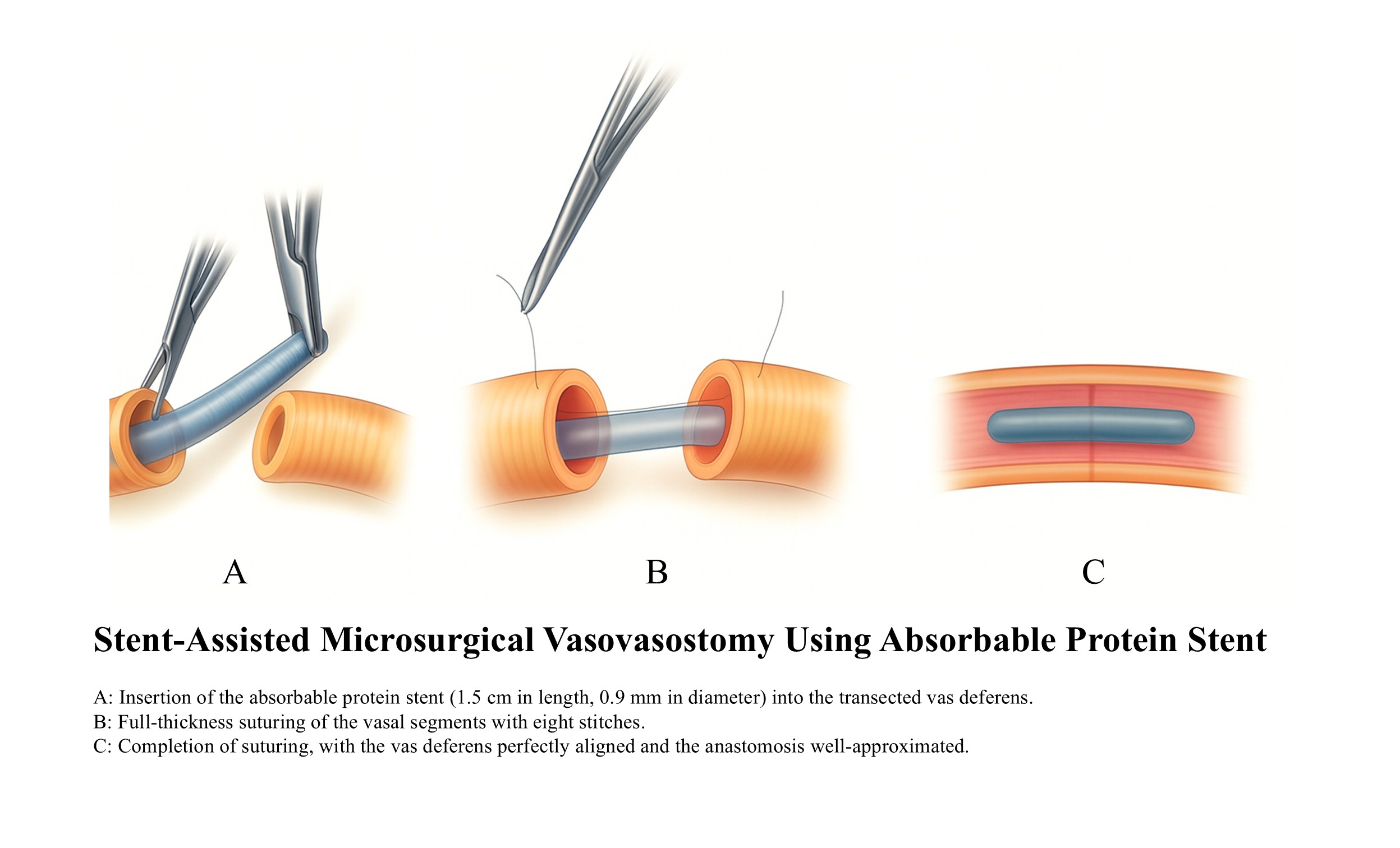Sat, Dec 20, 2025
[Archive]
Volume 23, Issue 9 (September 2025)
IJRM 2025, 23(9): 723-738 |
Back to browse issues page
Ethics code: TCMF1–2021074
Download citation:
BibTeX | RIS | EndNote | Medlars | ProCite | Reference Manager | RefWorks
Send citation to:



BibTeX | RIS | EndNote | Medlars | ProCite | Reference Manager | RefWorks
Send citation to:
Tu X, Zhang H, Liu Z, Feng J, Zhang Y. Investigation of a novel absorbable protein stent for microsurgical vasovasostomy in rats: An experimental study. IJRM 2025; 23 (9) :723-738
URL: http://ijrm.ir/article-1-3494-en.html
URL: http://ijrm.ir/article-1-3494-en.html
1- Department of Urology, The First Affiliated Hospital of Guangzhou University of Chinese Medicine, Guangzhou, China.
2- Chair of Endocrinology and Medical Sexology (ENDOSEX), Department of Experimental Medicine, University of Rome Tor Vergata, Rome, Italy. & Department of Infertility and Sexual Medicine, Third Affiliated Hospital of Sun Yat-Sen University, Guangzhou, China.
3- Department of Infertility and Sexual Medicine, Third Affiliated Hospital of Sun Yat-Sen University, Guangzhou, China.
4- Department of Infertility and Sexual Medicine, Third Affiliated Hospital of Sun Yat-Sen University, Guangzhou, China. ,zhxml@sina.com
2- Chair of Endocrinology and Medical Sexology (ENDOSEX), Department of Experimental Medicine, University of Rome Tor Vergata, Rome, Italy. & Department of Infertility and Sexual Medicine, Third Affiliated Hospital of Sun Yat-Sen University, Guangzhou, China.
3- Department of Infertility and Sexual Medicine, Third Affiliated Hospital of Sun Yat-Sen University, Guangzhou, China.
4- Department of Infertility and Sexual Medicine, Third Affiliated Hospital of Sun Yat-Sen University, Guangzhou, China. ,
Abstract: (319 Views)
Background: Microsurgical 2-layer vasovasostomy is a commonly used technique to treat vasal obstruction in male infertility, and optimizing the surgical approach has important clinical implications.
Objective: To compare the differences between stent-assisted vasovasostomy and the conventional technique in terms of operative time, vasal patency rate, and reproductive function.
Materials and Methods: This experimental study included 54 male Sprague-Dawley rats (8-9 wk, 300 ± 15 gr) and 12 female rats (7-8 wk, 250 ± 13 gr, used for co-housing experiments). The male rats were randomly assigned to 3 groups (n = 18/each): control groups, conventional groups, and stent groups. Postoperative assessments were performed at 2, 5, and 8 wk, including operative time, vasal patency rate, morphological changes (such as epithelial integrity and granuloma formation), immune response (serum immunoglobulin G and anti-sperm antibodies), and reproductive function (semen quality, pregnancy rate, and reproductive hormone levels).
Results: The average operative time in the stent group was significantly shorter than in the conventional group (28.8 ± 5.2 min vs. 70.4 ± 4.0 min, p < 0.001). The vasal patency rates were 100% and 91.7%, and the pregnancy rates were 83.3% and 75.0% in the stent-assisted and conventional groups, respectively. No statistically significant differences were observed between the 2 groups in terms of immune response (serum immunoglobulin G, anti-sperm antibodies), semen parameters, or reproductive hormone levels. Histological examination showed that most anastomotic sites exhibited good structural integrity without marked inflammation, with only one rat showing mild granuloma formation.
Conclusion: The absorbable protein stent shortens the operative time of vasovasostomy while maintaining favorable patency and reproductive outcomes. It shows promising potential for optimizing microsurgical vasovasostomy in clinical practice.
Objective: To compare the differences between stent-assisted vasovasostomy and the conventional technique in terms of operative time, vasal patency rate, and reproductive function.
Materials and Methods: This experimental study included 54 male Sprague-Dawley rats (8-9 wk, 300 ± 15 gr) and 12 female rats (7-8 wk, 250 ± 13 gr, used for co-housing experiments). The male rats were randomly assigned to 3 groups (n = 18/each): control groups, conventional groups, and stent groups. Postoperative assessments were performed at 2, 5, and 8 wk, including operative time, vasal patency rate, morphological changes (such as epithelial integrity and granuloma formation), immune response (serum immunoglobulin G and anti-sperm antibodies), and reproductive function (semen quality, pregnancy rate, and reproductive hormone levels).
Results: The average operative time in the stent group was significantly shorter than in the conventional group (28.8 ± 5.2 min vs. 70.4 ± 4.0 min, p < 0.001). The vasal patency rates were 100% and 91.7%, and the pregnancy rates were 83.3% and 75.0% in the stent-assisted and conventional groups, respectively. No statistically significant differences were observed between the 2 groups in terms of immune response (serum immunoglobulin G, anti-sperm antibodies), semen parameters, or reproductive hormone levels. Histological examination showed that most anastomotic sites exhibited good structural integrity without marked inflammation, with only one rat showing mild granuloma formation.
Conclusion: The absorbable protein stent shortens the operative time of vasovasostomy while maintaining favorable patency and reproductive outcomes. It shows promising potential for optimizing microsurgical vasovasostomy in clinical practice.
Type of Study: Original Article |
Subject:
Reproductive Andrology
Send email to the article author
| Rights and permissions | |
 |
This work is licensed under a Creative Commons Attribution-NonCommercial 4.0 International License. |








